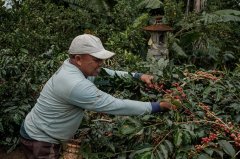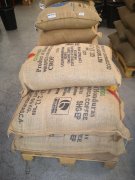The story of new varieties of Honduran coffee beans what are the varieties and characteristics of Honduran boutique coffee?
In addition, each of the six coffee growing areas in Honduras has at least two or three of the five major Arabica coffee varieties:
Bourbon
Kaddura
Iron pickup
Kaduai
Pacas
Lempira
IHCAFE-90
Parainema (Sarchimor type)
Common varieties of Honduran coffee
Instituto Hondure ñ o del IHCAFE is an organization that aims to promote the social and economic sustainability of coffee growers by promoting local coffee production. As part of their efforts to promote Honduran boutique coffee to the world, they divided its coffee producing areas into six regions: Copan, Opalaka, Montesilos, El Paleso, Agarta and Comayagua. According to IHCAFE, these are some common varieties of Honduran coffee:

Lempiral is a mixture of Caturra and Timor. It produces high yields of medium-sized beans and thrives in warm and acidic soil. It is small, has bronze leaves and needs a lot of nutrition. It is vulnerable to rust, a fungus characterized by small yellow leaf spots that cause fallen leaves and berries.
Bourbon is an important variety that produces beans at high altitudes and usually produces low yields when growing in shade. Although it has been replaced by other varieties (including Caturra, Catuai and Mundo Novo) in many parts of the world, it is still a boutique coffee worth investing in as long as it takes time and effort.
Catuai is a hybrid with high yield potential. Today, it accounts for nearly half of all Arabica coffee grown in Honduras. Because it is very small, it can produce more beans in less space. In appearance, it has green leaves and medium-sized beans, as well as red and yellow varieties. However, it is very vulnerable to coffee leaf rust.
Caturra, a natural variant of bourbon, was first discovered in Brazil more than a century ago. Like Catuai, it is a relatively small factory that can increase productivity. However, it is very sensitive to coffee leaf rust, which is why it is used to cultivate more resistant varieties. It is a compact plant with green leaves, medium-sized beans, good yield and good cup quality.
Pacas is another bourbon mutation found in El Salvador and is still produced in that country. It was first introduced to Honduras by IHCAFE in 1974. Pacas produces standard production of beans. It is a dwarf plant with green tip leaves. Although it is suitable for high altitude areas, it is also well adapted to low altitude areas. Its maturity and productivity are average, and it needs the right amount of nutrition. It is also vulnerable to coffee leaf rust.
Iron pickup is one of the oldest and most important C. arabica coffee in the world, its history can be traced back to 1700s. It produces a small amount of coffee beans and has good cup quality. It is a tall plant with bronze leaves that produce soybeans. However, it is susceptible to major diseases and requires standard maturation time and nutrients.
IHCAFE90 can produce precocious and high yield. However, it requires a lot of fertilizer. In terms of appearance, it is a small plant with dark bronze leaves and medium-sized beans. However, it can lead to poor quality of cups at high altitudes and are vulnerable to coffee leaf rust and Ojo de Gallo.
Villa sarchi is a natural mutant of Bourbon, but a single gene mutation means it is smaller. It originated in Costa Rica and was introduced to Honduras by IHCAFE in 1974. Villa Sarchi thrives at high altitudes and can tolerate strong winds. It has green leaves and below-average bean size. Like IHCAFE 90, it needs a lot of nutrition. However, it is vulnerable to coffee leaf rust and Ojo de Gallo.

Many varieties of coffee that are booming in Honduras are introduced by IHCAFE. As mentioned earlier, in the 1970s, they introduced three varieties from neighboring countries: Pacas from El Salvador, Villa Sarchi from Costa Rica and Catuai from Guatemala. In addition, they created two new varieties in the 1990s: IHCAFE 90 and Lempira. New varieties were born to balance disease resistance and coffee quality. Bourbon and Typica are well-known and relatively common varieties. Despite their good quality, their yields are very low and are vulnerable to coffee leaf rust and other plant diseases. Therefore, they need to be more careful in the production and processing process. However, producers can expect high prices for these varieties, provided they are carefully cultivated. Lempira and IHCAFE 90 may be more resistant than other varieties, but they also need more nutrition, which will be an expensive investment for producers. For this reason, their prices will also be relatively high-but buyers and consumers will get good quality coffee. Both Caturra and Catuai are highly susceptible to certain diseases, which means they need care and high prices to make producers viable. Pacas and Villa Sarchi are of high quality and high output, so buyers can expect a good cup shape. However, since producers have to make extra efforts to take care of the crop, prices must be relatively high.
Important Notice :
前街咖啡 FrontStreet Coffee has moved to new addredd:
FrontStreet Coffee Address: 315,Donghua East Road,GuangZhou
Tel:020 38364473
- Prev

Flavor and taste characteristics of Honduran coffee beans, the most popular coffee brand in Central and South America
What makes coffee in Honduras special? You know, there are countless excellent coffees in Central and South America. Why do Colombian coffee and Brazilian coffee stand out from the crowd? Let's take a look at the uniqueness of Honduran coffee on Qianjie today. The most luxuriant and purest coffee growing place in the region: unfortunately, the United States
- Next

The best flavor and taste of coffee beans in Honduras describe the ranking of native coffee beans in Honduras
Like its Central American neighbors, Honduras is a major coffee-growing area. In fact, it may come as a surprise that Honduras has so far produced and exported more coffee than any other Central American country. In 2020, according to the International Coffee Organization, Honduras produced 6100000 bags of 60 kg coffee. This is the same as 3750000 of Guatemalan coffee
Related
- Detailed explanation of Jadeite planting Land in Panamanian Jadeite Manor introduction to the grading system of Jadeite competitive bidding, Red bid, Green bid and Rose Summer
- Story of Coffee planting in Brenka region of Costa Rica Stonehenge Manor anaerobic heavy honey treatment of flavor mouth
- What's on the barrel of Blue Mountain Coffee beans?
- Can American coffee also pull flowers? How to use hot American style to pull out a good-looking pattern?
- Can you make a cold extract with coffee beans? What is the right proportion for cold-extracted coffee formula?
- Indonesian PWN Gold Mandrine Coffee Origin Features Flavor How to Chong? Mandolin coffee is American.
- A brief introduction to the flavor characteristics of Brazilian yellow bourbon coffee beans
- What is the effect of different water quality on the flavor of cold-extracted coffee? What kind of water is best for brewing coffee?
- Why do you think of Rose Summer whenever you mention Panamanian coffee?
- Introduction to the characteristics of authentic blue mountain coffee bean producing areas? What is the CIB Coffee Authority in Jamaica?

